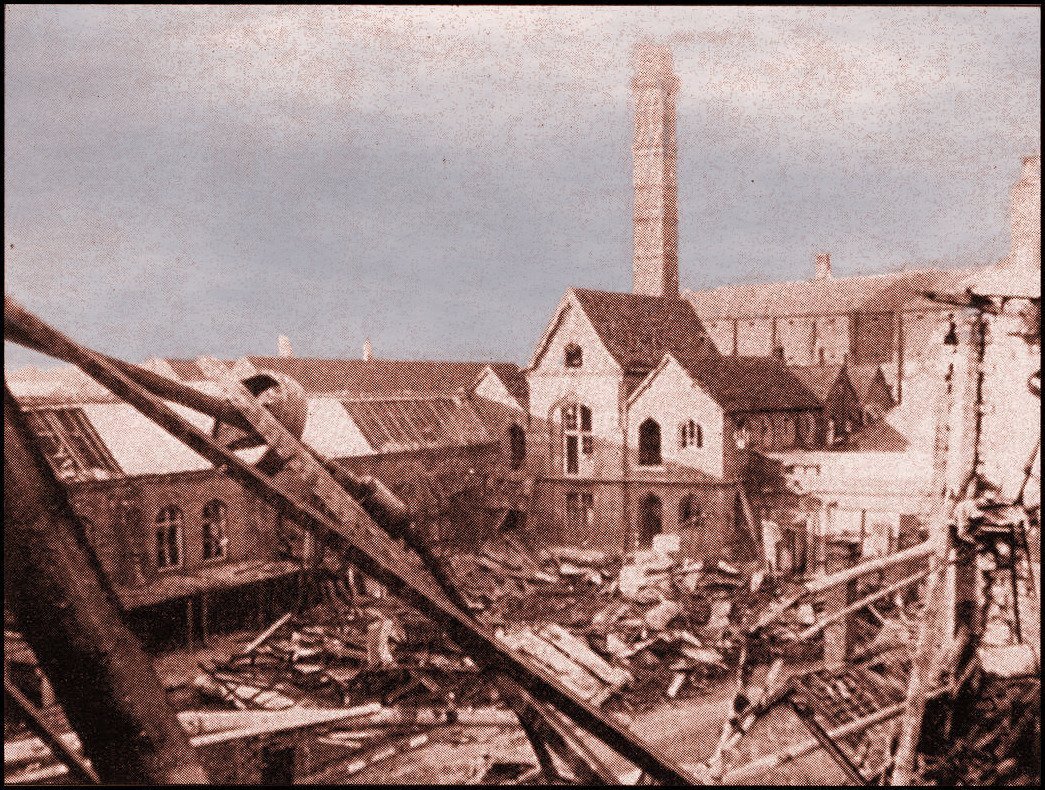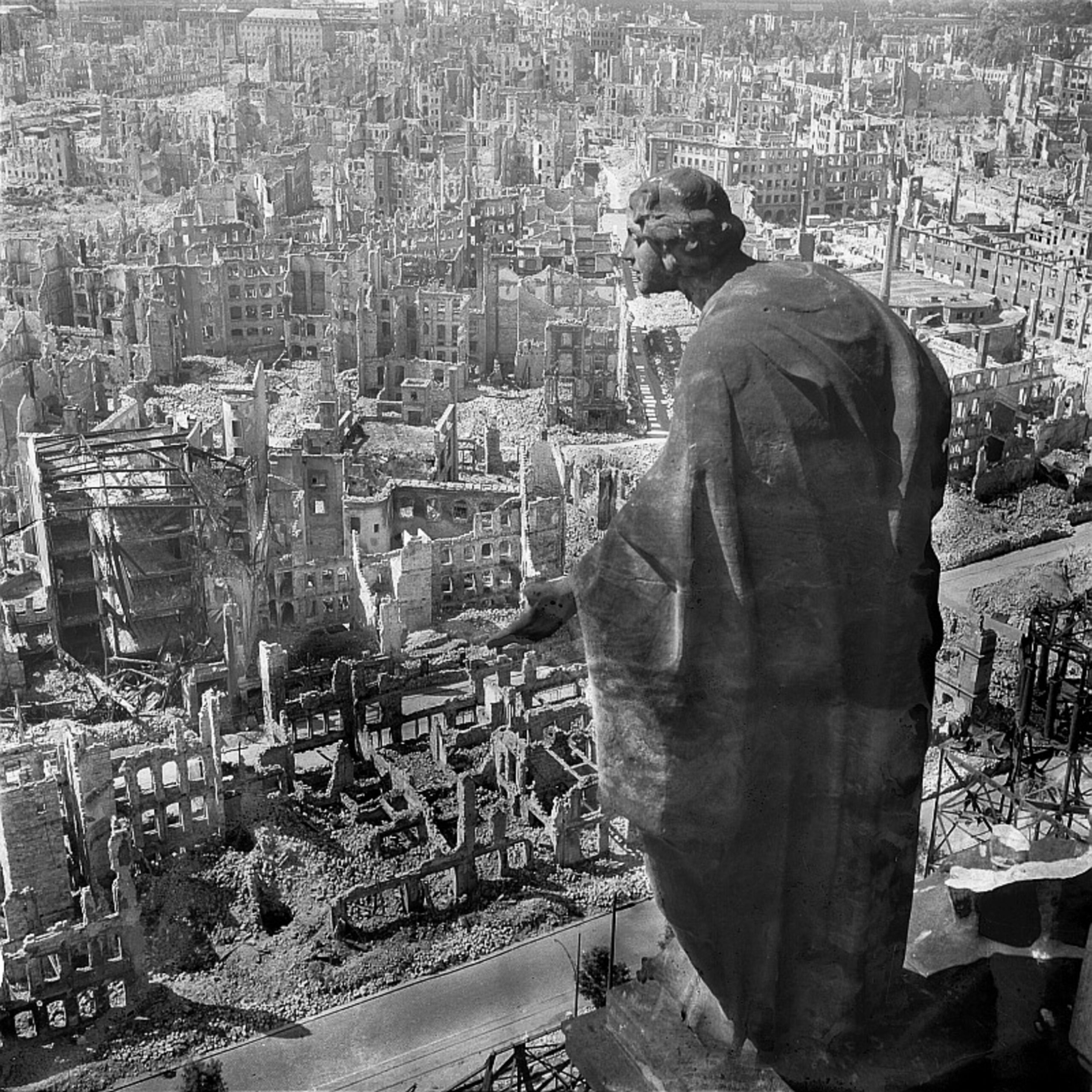Firestorm
It was the end of July 1943. Hamburg’s firefighters had spent days trying to stem the damage from the British bombing raids that began on July 24 and were codenamed Operation Gomorrah. High explosives had not just destroyed numerous buildings, but had also torn huge craters into the streets, which made rescue attempts difficult. Although water reserves were running low, it seemed like they would manage.
But then, on the night of July 27, a fleet of 730 British bombers appeared over the city. Over 2,300 tons of bombs were dropped in just one hour, including 17,000 incendiary bombs. Major fires broke out all over the city, which soon merged together into a storm of fire. Wooden structures combusted under the immense heat of up to 800°C. The strong summer winds began to drive the inferno through the streets and the heat drove them to hurricane speeds of 240km/hr.
Craving oxygen, the firestorm sucked at the air with such a force that buildings collapsed and trees were uprooted from the ground. People were sucked into the flames and immediately incinerated. Thousands of others died slowly of carbon monoxide poisoning in shelters. Hamburg burns. The flames destroyed 12 square miles and killed more than 18,500 people that night alone.
By August 3, after two more raids, 60 per cent of Hamburg had been charred and more than 35,000 of its inhabitants perished. The Germans were stunned, dazed with disbelief.
For British bomber command it was considered a resounding success. The scale of the conflagration and the ensuing firestorm weren’t an accident or a byproduct of the bombing. It worked just as intended.
Planned to the very detail
Hamburg was top of the target list for well over a year. British scientists had been studying the meteorological conditions and wind speeds in and out of the city for months. High winds would be the best catalyst for the firestorm they sought to unleash. Questions revolved around how many fires needed to be started until it became an uncontrollable force of its own – one that would ultimately overwhelm the German fire-fighters.
Bombing trials were scheduled and models of the city’s urban areas were built to accurately study the vulnerability of German houses to fire. The main target of the incendiary raid was to be the most densely packed residential area in the city, close to its centre. At first a group of pathfinder bombers would drop aluminised strips to create false echoes on the German radar screens, shielding the coming planes from coordinated fighter attacks. A second group would drop small anti-personnel explosives with delayed action triggers to intimidate the rescue efforts. Some were timed for between 3 and 10 minutes after impact, others would explode if they were hit by a jet of water. Then the main force would arrive and drop incendiaries, such as magnesium bombs mixed with an oil-base. The Mark-II incendiary bomb was a deadly mixture of white phosphorus and benzol gel. Everything worked as planned, in creating the perfect firestorm. Hamburg was burnt to ashes.
British Prime Minister Winston Churchill had promised Soviet High Command a year before that although an invasion of Europe was not yet possible, they would continue to attack the Germans on every possible occasion. At first, the sporadic bombing raids against German cities had been a way for the Royal Air Force to show defiance. When they happened, the Germans had to use valuable military and administrative resources to fight them off, and these were desperately needed at the battlefronts. But now, the British were determined to turn those raids into a strategic concept. One that would break not only Germany’s military capabilities, but break the population’s spirit also.
Air-marshal Arthur Harris
Churchill had just the right man at hand to fulfill such a goal. Air-marshal Arthur Harris had been appointed the commander-in-chief of the British Royal Air Force, as part of the new Area Bombing Directive, in February 1942. Harris already had a reputation as a ruthless and uncompromising leader, who held personal contempt for the Germans and the totalitarianism of the Nazis. He fully expected air-power to win the war, and possibly even avoid a costly invasion of Europe against ‘entrenched fanatics’. If he just had a fleet of a thousand bombers, Harris argued, he could reduce any major German city to rubble.
His proposed mass-carpet-bombing campaigns would shorten the war, and the more ruthlessly they acted, the more it would save Allied lives in future. Harris proposed that instead of attacking single factories or military targets, they should bomb the urban centres of German cities. For him, the tightly packed worker districts were valuable targets. Total war was the people’s war. Each industrial worker was as important to the war effort as the soldier at the front was. If the bombers targeted the urban areas, they would affect several industries at once too, either through absenteeism or the death of the workers. If they wanted to win this war, Harris argued, they would have to kill a lot of Germans either way. De-housing the Germans was also the most likely way to break their will to resist, as losing one’s home was considered to have the most demoralising effect.
“The Nazis entered this war under the rather childish delusion that they were going to bomb everybody else and nobody was going to bomb them. At Rotterdam, London, Warsaw, and half a hundred other places, they put that rather naive theory into operation. They sowed the wind and now they are going to reap the whirlwind. Cologne, Lubeck, Rostock — those are only just the beginning. We cannot send a thousand bombers a time over Germany every time, as yet. But the time will come when we can do so.” – Arthur Harris, June 1942
Operation Gomorrah

Such biblical terms were not accidental. The attack on Hamburg was codenamed Operation Gomorrah for the apocalyptic scenery it would produce. Like the British propaganda said, Harris also stood behind the fact that the incendiary attacks on German cities were not simple acts of terror-bombing. They were retaliation; acts of revenge for what the Luftwaffe had done during the Battle of Britain and the Blitz.
The bombing of Coventry in November 1940 was seen as the example of German cruelty. Although the Luftwaffe’s aim had been to cripple the local aircraft industry, much of its heavy bombs and incendiaries had fallen upon the residential areas, causing a high civilian death toll and the destruction of the city. Harris and British bomber command would now, as the war turned, “Coventry” German cities as well.
In the first four months of 1945, British bombers dropped four times the bomb-tonnage on German cities that the Luftwaffe had dropped during its 10-month-long campaign against Britain.
On the night of February 13, Dresden burned. 800 Lancaster bombers dropped more than 2,600 tons of bombs on the mostly undefended city. Nearly half of them were incendiary, and more than 15 square miles of the city were devastated by fire. Dresden’s historic centre burned to ashes, as more than 75,000 houses succumbed to the firestorm. Over 25,000 people are estimated to have been killed that night.
Even in Britain people began to question such actions. Was this really justified? Was this not just terror against civilians? Dresden hadn’t been a fortress city, nor did it have major war-related industries. Instead, it was full of refugees and evacuees fleeing the Eastern Front, but Harris wanted to see the city bombed because it would make the German administration in the sector collapse, and would delay the transport of German troops to the front. It was war after all.
But even as the final phase of the war began and more cities burned, there was no sign of surrender, not in Germany, not in Japan. The US had been confronted by the destructiveness of modern air power when Japanese Naval aircraft attacked Pearl Harbor on December 7, 1941. Actually, Harris lived in Washington DC at the time, and was busy closing a deal with the American aircraft industry as news of the air raid came in.
How do you destroy a city from the air?

Since the early 1930s, American military planners had foreseen the need for long-range bombers for a future war fought far from US shores, so they had been developed. While any retaliation was seen as a good thing, Tokyo itself was on the target list for retaliation bombing after the Doolittle Raid of April 1942. That had little more than a propaganda effect, similar to the initial British raids on the German Rhineland. But then with Harris establishing a working relationship between the British and American air-leaders, the US air force began studying the efficiency of fire-bombing. The development of the B-29 Superfortress Bomber pretty much embodied the possibility of destroying a city from the air. With a range of over 3,200 miles- over 5,000km, it could easily reach the Japanese homeland from US forward air bases, and each plane could deliver a bomb load of up to 20,000 lb (over 9,000 kilos).
Such a fleet would not only get revenge for Pearl Harbor, but have a 1,000-fold effect. By February 1945, they were ready and US Air force General Curtis Le May ordered the first large-scale bombing runs against Tokyo. By then, Japanese defensive capabilities had been very much diminished. Their air force barely existed anymore, the fleet was shattered and industry marginalised. Still, Tokyo refused to surrender, even after the first low altitude raids began. Japanese people still went to work as their families grew accustomed to the daily air raids. Each night they went to bed fully dressed, to not waste time in case of an attack. But this was to little avail on the night of March 9, when 279 B-29 bombers appeared over the skies of the capital. In the darkness at an altitude of just under 2,500 feet, they dropped more than 1,600 tons of bombs. Most of them were cluster bombs, each releasing several smaller napalm and oil-based incendiary bomblets. M-47 incendiaries, a mix of jelled gasoline and white phosphorus ignited as they dropped into the tightly packed residential areas.
The ensuing conflagration was even more devastating than those in Germany. A firestorm was ignited as the columns and walls of flames were whipped through the streets. Since the Japanese used more wood in the construction of their buildings than the Europeans, the devastation was more total. Large parts of the capital were simply obliterated by the flames, leaving more than a million people homeless. The numbers are still disputed, but somewhere between 88,000 and 200,000 people fell victim to the flames.
Setting a dangerous precedent
In the end it mattered little if such raids were justified or not. Firebombing gave way to a dangerous precedent. Such carpet-bombing runs with high explosives and incendiaries did not just kill people. They incinerated them; they blew them to pieces. They deliberately asphyxiated them or burned them alive.
It was another line crossed, yet another extreme of total war. When months later, arguments raged about the ethical use of the atom bomb, people began pointing fingers. To Hamburg, to Dresden, to Tokyo. Mass extinction was already here. The Atom bomb, so an argument went, might actually be more humane.
The story of Operation Gomorrah heavily inspired our song ‘ Firestorm ‘, which is featured on our album, The Art Of War. Take a look at the lyrics we wrote here.
If you’re interested in a more visual interpretation of this story, watch our Sabaton History episode, Firestorm – Strategic or Terror Bombing?:





















